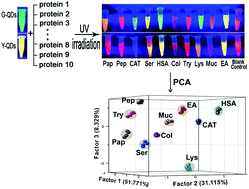Light-induced self-assembly of bi-color CdTe quantum dots allows the discrimination of multiple proteins†
Abstract
We have found that the addition of proteins can greatly influence the light-induced self-assembly (LISA) behavior of bi-color thioglycolic acid (TGA)-capped CdTe Quantum Dots (QDs) and thus cause significant changes of their fluorescence (FL) signals (color and intensity), according to which a dual-channel FL sensor can be established for simultaneous discrimination of multiple proteins. The sensor is successfully used for the identification of ten native proteins and ten thermally denatured proteins and eight native proteins artificially added in human urine, respectively, during which process principal component analysis (PCA) is utilized to differentiate the targets based on their corresponding FL change patterns. This assay has provided a visual and simple method for the discrimination of various analytes, which may have great potential in the study of conformational changes of biomacromolecules and the analysis of real biological fluids.



 Please wait while we load your content...
Please wait while we load your content...